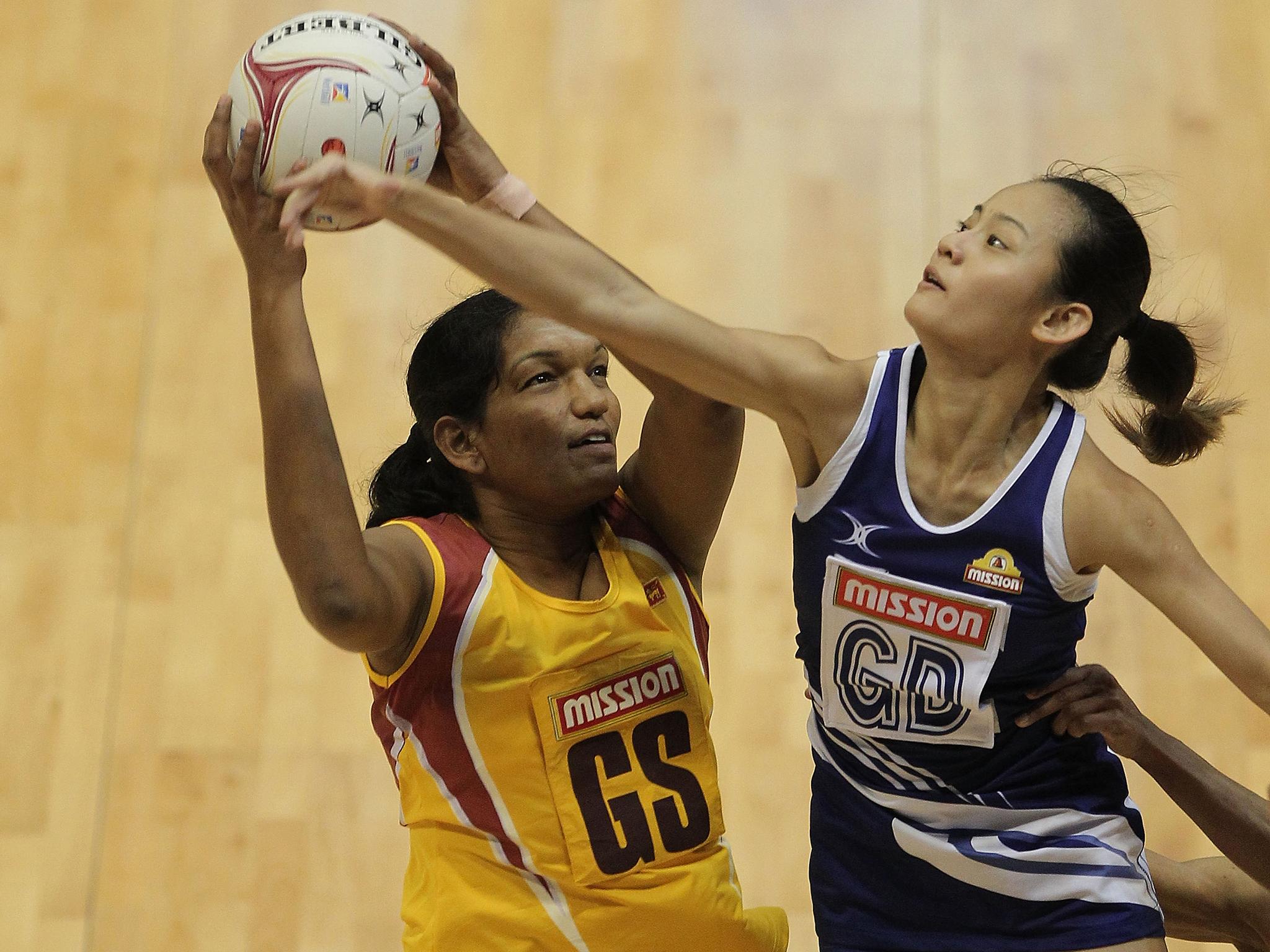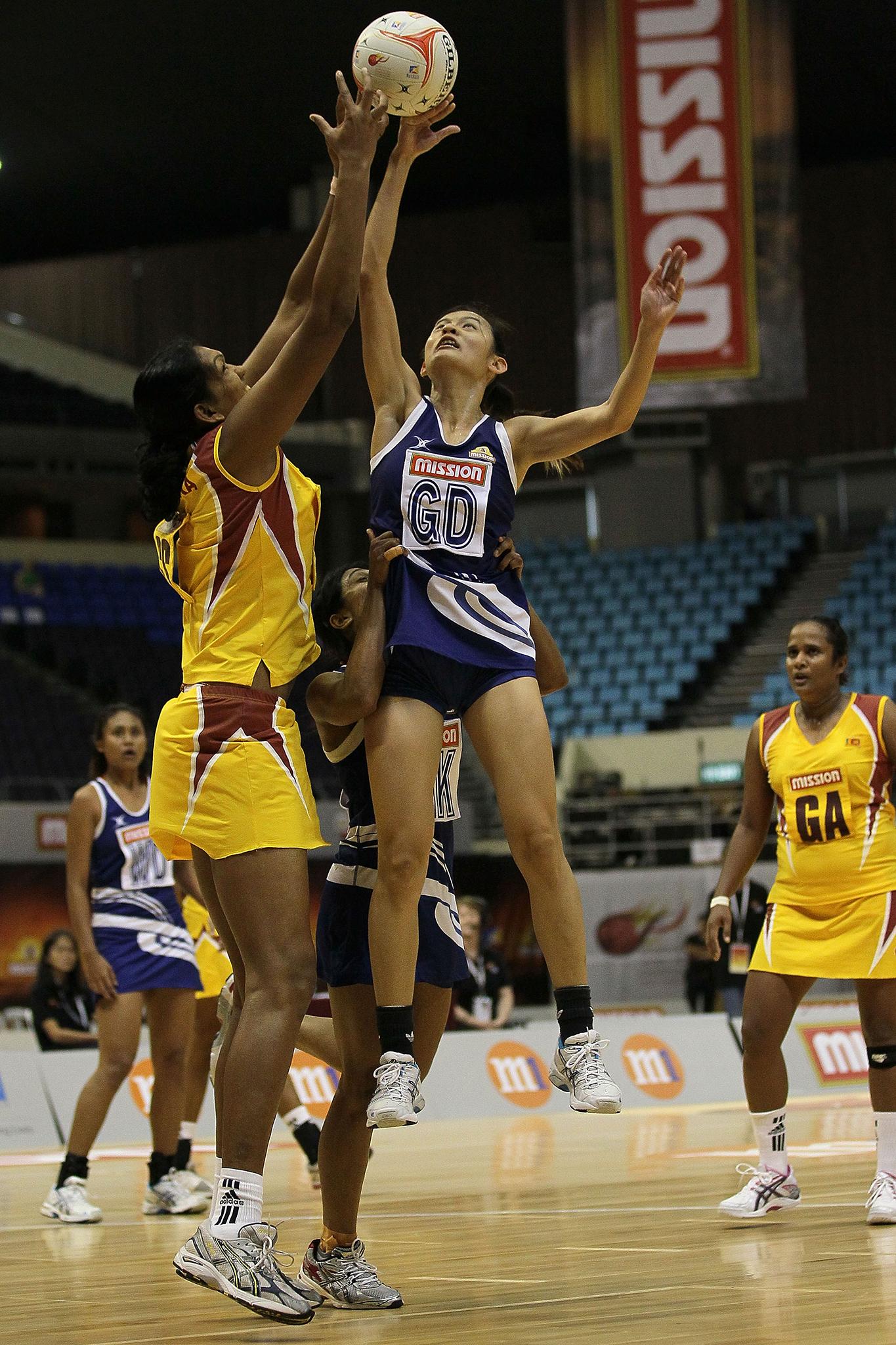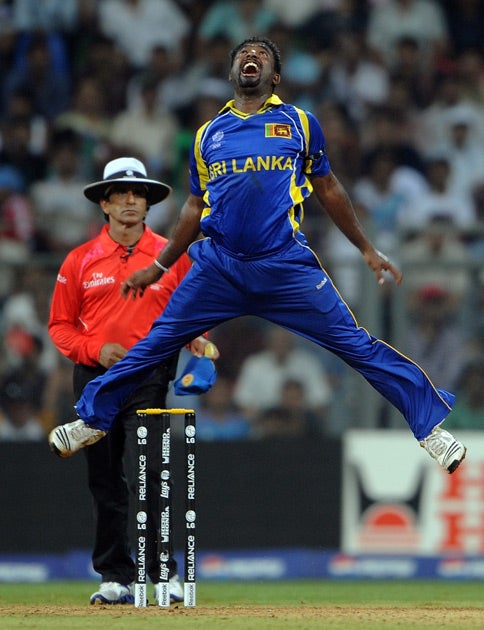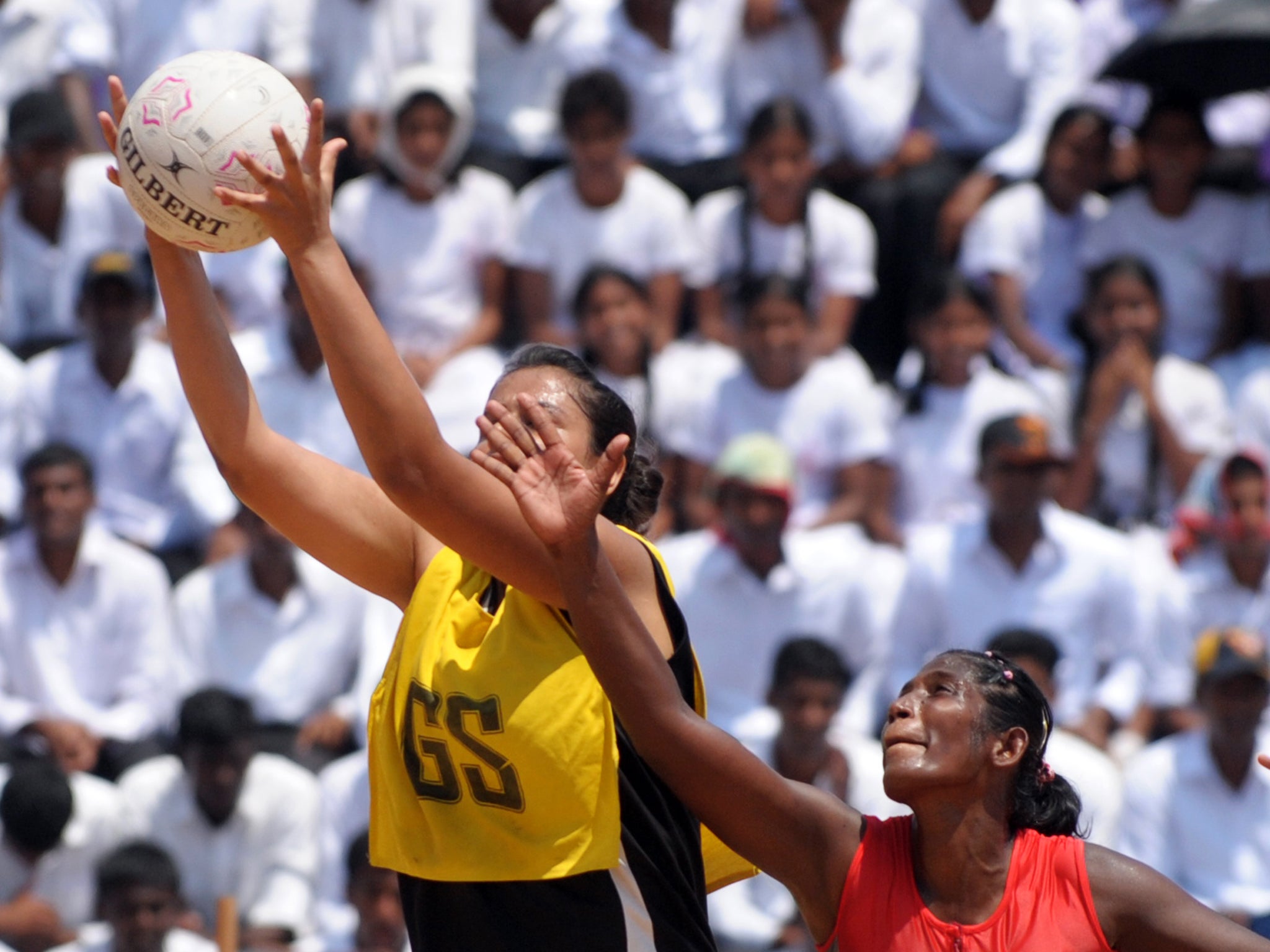Sri Lanka’s Genie towers above the competition, but she hasn’t had an easy ride
In other countries she’d be an Olympic volleyballer, or perhaps a millionaire basketball star. But as Jarrod Kimber explains, this world-class netball player has had to battle to get on the court

Singapore goal defender Qingyi Lin is floating above the court. It would be ethereal or beautiful if she weren’t also scrambling to deflect a shot at a height usually reached with a ladder. The reason she’s above the ground is that goal keeper Premila Hirubalan is holding her by the waist.
This is not a standard move in netball and it wouldn’t be named until the next year, when it was dubbed the Harrison Hoist. It looks like a rough ballet move or something from the rugby field.
We are at the 2011 World Netball Championships, and Singapore are playing their arch-rivals, Sri Lanka. These are the best teams in Asia, but there’s one big difference: to get above two metres in the air it takes two Singapore women; for Sri Lanka, it takes one. Tharjini Sivalingam is 208cm tall (6ft 10in).
She’s the tallest woman in the netball universe. If she were in the WNBA (the Women’s National Basketball Association), she’d be the biggest there too; and she’s taller than some male NBA centres. She’s also got Lennox Lewis, Peter Crouch and Tyson Fury covered.
According to Averageheight.co Sri Lanka is the eighth shortest country for males and the ninth smallest for females. The average Sri Lankan woman is 151cm tall, while for men it’s 163cm. Sivalingam’s father and tallest brother are 180cm; so she’s almost a foot taller than them.
And she has talent as well as height. In that game against Singapore, Sri Lanka scored 62 goals, of which Sivalingam bagged 60, with just one miss.
Netball, like basketball, is an efficiency sport. Both teams have virtually the same amount of ball time, so it’s what you do with it that matters. If you aren’t efficient, if you throw possession away, allow it to be stolen, or clang your shot, you’ve wasted your chance.
In that World Championship, Sri Lanka had six games; Sivalingam had 296 shots on goal, she scored 290 of them.
They call Sivalingam the genie. She almost never misses. But Sri Lanka almost missed her.

Sivalingam was born into a family of vegetable farmers from the Jaffna Peninsula in Sri Lanka’s far north. What should have been a happy childhood turned into horror when her village ended up on the front line of the civil war between the Tamil Tigers and the Sri Lankan government. The entire community moved towards the coast.
“My house was destroyed,” says Sivalingam in her improving but broken English.
She doesn’t know how her home was wrecked, or even by who, just that it happened. She grew up with “no phone, no light, no running water, no nothing”. To study she used kerosene lamps, but for a couple of years there was no school to attend. With her household unable to farm, they relied on money from an uncle.
Her family is Tamil, at a time when being so was not a great thing in Sri Lanka. But beyond the war, she had her own separate problems.
That’s why we are champions, we have to overcome other things other teams don’t, hard-working
“Compared to others I was always tall”, she says. When she kept growing, other children bullied her. “Everyone would look at me and laugh, because I was different. I was very sad”.
War, poverty, lack of education, and bullying was her life.
As a young girl Sivalingam had a fall and was taken to hospital. The doctors realised she had a hormonal imbalance, and said she’d continue to grow until around 22. She did, and the bullying kept going too.
At 20 she moved to Batticaloa, on Sri Lanka’s east coast, to attend university. It was quite the distance from her home, geographically and culturally.
“I am born in Jaffna, everyone is looking at me, I don’t understand the language. I had to ride a bike too small for me. Six and 10 kilometres, all very difficult,” she concludes
Soon after though she would play her first game of netball. She played barefoot on a muddy field in a long skirt. The standard skirts seemed immodest to her. Barely a month after she started playing, officials from the Netball Federation of Sri Lanka attended a game and brought her straight into the national system.
She’d barely played the sport, spoke “not one word even” of Sinhalese (her teammate’s language) and was still unsure of the uniform, but her talent and height were undeniable. They gave her specialist training, and they bought her the biggest shoes on sale in Sri Lanka, size 12. It turned out she was a 14, and the smaller ones hurt her feet.
But netball was a chance at a better life for Sivalingam. Sure enough, she stopped being bullied when she made the national team. The swift advancement of her career allowed her to learn Sinhalese, get a decent job, understand more about the world and buy shoes that fit. People still looked at her on the street, but instead of laughing at her, they admired her.
Netball writer Estelle Vasudevan from ThePapare recently said: “In women’s sport, netball is the biggest in Sri Lanka”. In the 2018 SLT Silk Sports Awards the netballers were named best female team in the country. The women’s cricket side may overtake it in the future, given Sri Lankans’ love for that sport. For now though, being the best-known player in one of the better-followed netball teams in the world is something that Sivalingam is proud of. Netball has given her so much, but she wished there was more to give so the sport could grow.
There’s little funding, even though the Sri Lankan team almost always qualifies for netball’s biggest events. Even after winning this year’s Asian championship, their fifth victory, money remained in short supply. Because of the lack of funds, the players don’t continuously prepare as a national group. There’s no dedicated netball centre; sometimes they train outdoors. The team bus is too small for most of the taller players, let alone Sivalingam. She wonders what they could achieve if they had the professional status of their cricketing counterparts.
But she also thinks the need to keep fighting helps: “That’s why we are champions, we have to overcome other things other teams don’t, hard-working”.
If Sri Lanka as a nation was being rated on efficiency like Sivalingam for her shooting, they’d be nowhere near 98%.
Still, the advantages of money in sport can’t be denied. Netball prodigies in Australia, England and New Zealand are brought up with shoes, play the game as kids, and have access to professional facilities.
The private sector has stepped up, as it often does in Sri Lanka to support local athletes. Sivalingam has an economics degree, but the reason she works in finance is that she represents the Seylan Bank netball team. This is common in Sri Lankan sport: cricket star Rangana Herath just retired from the sport and said he’d continue to work for the bank that supported him during his sporting career. It was at the bank where Sivalingam was first paired with coach Thilaka Jinadasa.
Before then, Sivalingam’s training was 500 shots in the morning and then 500 shots in the evening. “My arms would hurt”, she recalls.
Jinadasa, a netball coach who represented Sri Lanka at the Seoul Olympics as a 100m hurdler, thought they could fix other areas.
“She was not that mobile”, says Jinadasa, “and they kept her near the goal and lobbed balls to her. She didn’t have that much idea about netball”.
Jindasa made her new charge work on strength, got her running, and then fixed her feet. “We did co-ordination activities, so when you catch the ball, there is very strange footwork in netball, so we taught her how to land correctly.” Jindasa took this tall person with soft shooting hands and turned her into a netballer.

They also looked at where she stood on the court. Before, she would either rush to the ball or wait near the ring until it was lobbed to her. Jindasa realised that if Sivalingam were eight feet from the ring – halfway to the perimeter of the goal circle – she would be closer to the players for passes, and yet still only one step from an easy shot.
These are all things she should have learned before she was 12, and instead, she was learning them when already a star of the national team.
It’s a real shame that no one really got her at a young age, because she then would be a world beater. She hasn’t had that development, so who knows the levels she could have achieved if she’d been exposed to that early on
Even before Sivalingam, the Sri Lankan netball team was strong. But she is their first true star player. In 2011 she was crowned best shooter for her goal percentage at the World Championships. No other Sri Lankan player has won that kind of accolade. Having her in the side allows them to play a different form of netball.
For most, netball is a game of speed and precision. Teams use quick movements and distinctive styles of passing. They employ the side, bullet and bounce passes to feed the ball to a goal attack or shooter. There are dummy runs, cuts and feints. Most sides need two players who can shoot, often even exchanging possession in the shooting circle for closer shots. They might also substitute those players as the game goes on.
Sivalingam never comes off the court, and there is rarely another Sri Lankan player near the goal circle. She does nearly all the shooting: at the 2011 World Championship she scored all but 14 of Sri Lanka’s goals. They just get the ball down the court as quickly as possible so that the opposition can’t double mark her. When Sri Lanka play netball, it’s like two different sports are being played. One is about pace and precision; the other is “genieball”.
Ultimately, it was her dominance for Sri Lanka that made her the island’s first professional netballer. Sivalingam plays in two Australian leagues; one is the Victorian Netball league, arguably the best state league in Australia. She has starred in both.
To make the most of her pay, she boards with her coach, Nicole Richardson. Not only was Richardson a star netballer – winning a Commonwealth gold for Australia – but she also won a bronze in softball at the 1996 Olympics. Richardson was in awe of her lodger, saying: “If the ball comes down at speed, and you’re able to isolate her in a one on one, she will be hard to beat. With a good line up around her, she’s almost unstoppable.”
But as good as Sivalingam is, she’s still someone who came to netball in her twenties.
As Richardson puts it: “It’s a real shame that no one really got her at a young age, because she then would be a world beater. She hasn’t had that development, so who knows the levels she could have achieved if she’d been exposed to that early on. If she had come through the Australian pathway, you actually wouldn’t be able to stop her.”
You can blame the war or the particular ethnic situation in Sri Lanka. But too many talented athletes never make the most of their abilities, because they aren’t seen or given the right opportunities. And even when they are found, they need the environment that Richardson came through, and good management. Sri Lankan netball has neither.
The situation in Sri Lankan sport is thus far from ideal, which is perhaps why Sivalingam recently experienced a long period of not representing the national team. She didn’t want to say much when asked about this. Instead, she shrugs and says: “administration, maybe”.

If Sivalingam won’t give the real reason, we can at least be fairly certain that it’s complicated. In the 2012 Asian Championship, Sri Lanka lost to Singapore by one goal; in the 2014 edition, they lost again. Because they finished in the top two, they still qualified for the World Championships. But the Netball Federation of Sri Lanka were upset, and there was an inquest into the team’s performance.
In 2015 they had a series of trials ahead of the worlds, and Sivalingam skipped the first round. She had told the federation she’d not be there but for reasons that are not clear, her non-appearance meant she was not picked for netball’s biggest tournament. Other star players Shashika Samarasinghe, Kumarani Silva and Mareesha Fernandoher were also overlooked for the tournament.
At the 2011 World Championship Sri Lanka won once and only lost one game by more than 10 goals. In 2015 they lost all of their matches by more than that margin, including an 89-17 defeat against South Africa, 101-18 against Malawi, and their old rivals Singapore beat them 59-32 in a playoff for last place.
When contacting the Netball Federation of Sri Lanka for this story, it turned out they had no website and not even an official Facebook page. The only phone number listed for them went to the private residence of someone who used to be involved. I also emailed the Department of Sports Development; they’ve not responded either.
If the trial story isn’t true, what we know is this: Sivalingam was the best shooter in the 2011 tournament and wasn’t at the 2015 tournament. Sri Lanka netball records aren’t easily attained, but by Sivalingam’s recollection, she played in September of 2014, and then next played for the national team in September 2018. Sri Lanka had a 6ft 10in golden-handed shooter, who spent four years not playing for them for what appears to be a minor misdemeanour.
That’s the world of Sri Lankan sport. This, after all, is the place where the Sri Lankan sports minister spent years signing off on the selection of the cricket team before games. A similar thing happened to Sivalingam’s coach Thilaka Jinadasa (now Sri Lankan national coach), who after coaching the side to the Asian championship in 2009, was not kept for the world championship she helped them qualify them for. That’s how it works there.
On every level, it’s incredible that Sivalingam ended up being successful. Brought up in a war zone, isolated by culture and language, bullied through childhood, talent-spotted only as an adult, ignored by the cricket-obsessed piublic, virtually unpaid, struggling as a female athlete, and left out of the team due to internal politics. This is not the story you’d expect from one of your greatest athletes.
In many other countries she’d be an Olympic volleyballer, or a millionaire basketball star. Somehow she’s had to battle to be known, to play at all, despite being so talented.
If Sri Lanka as a nation was being rated on efficiency, like Sivalingam is for her shooting, it would reach nowhere near 98%. When asked about how good Sivalingam could have been with access to professional training and facilities her coach Jinadasa said “1000 times better”. Richardson said, “The sky’s the limit”.
Sivalingam was lucky that her skills were noticed due to her height: netball’s officials couldn’t help but notice her, even if they were late to the party. It’s easy to see someone tall, but who else are Sri Lanka – and other countries – missing out on? How many natural ball strikers, gifted sprinters and incredible athletes are never noticed. Sri Lanka is as close as it gets to a single sport culture, but even in cricket – the game that provides them with much of their cultural identity – they miss or mismanage so much talent. The cricket authorities have been criticised for taking many players from elite schools and not casting a wider net. When they do, as world-record breaking spinner Muttiah Muralitharan proved, they can something extraordinary.
Sivalingam one day wants to be professor of Tamil studies. She’ll probably get a chance to do that, and it’s because of netball. Her amazing story is all because she played sport, yet she’s a more rounded person than simply a sports player, who will use her fame to move into other areas. As tall as she is, sport has helped her grow. Indeed, that is one of the key purposes of professional sport. For fans, it’s an emotional outlet or distraction; but for the players, it’s a chance to better themselves, to build their lives. Their prodigious gifts are a stepping stone to something better.
Sivalingam is currently preparing for the next world championship after Sri Lanka won the last Asian championship, defeating Singapore by 19 goals. She had 70 shots, missing two.
She’s called Genie, but Sri Lanka didn’t have to find a magic lamp to discover her, just look around the nation. There are probably many genies if they search for them. Sivalingam has a special talent, and the chances are, she is not the only one.
Join our commenting forum
Join thought-provoking conversations, follow other Independent readers and see their replies
Comments